Due to the US Government shutdown, the Smithsonian is temporarily closed. The Global Volcanism Program website will remain available but will not be monitored or updated. Status updates will be available on the Smithsonian homepage.


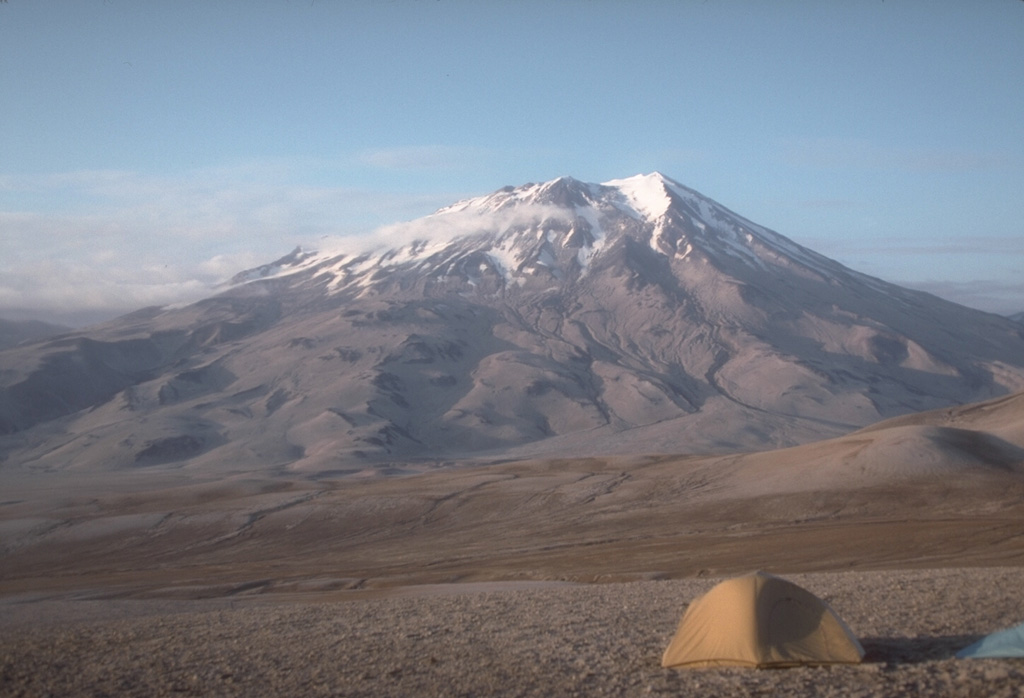
The Global Volcanism Program has no activity reports available for Griggs.
The Global Volcanism Program has no Weekly Reports available for Griggs.
The Global Volcanism Program has no Bulletin Reports available for Griggs.
|
|
||||||||||||||||||||||||||||
There is data available for 1 confirmed eruptive period.
1790 BCE ± 40 years Confirmed Eruption (Explosive / Effusive)
| Episode 1 | Eruption (Explosive / Effusive) | |||||||||||||||||||
|---|---|---|---|---|---|---|---|---|---|---|---|---|---|---|---|---|---|---|---|
| 1790 BCE ± 40 years - Unknown | Evidence from Isotopic: 14C (calibrated) | ||||||||||||||||||
|
List of 2 Events for Episode 1
|
|||||||||||||||||||
This compilation of synonyms and subsidiary features may not be comprehensive. Features are organized into four major categories: Cones, Craters, Domes, and Thermal Features. Synonyms of features appear indented below the primary name. In some cases additional feature type, elevation, or location details are provided.
Synonyms |
| Knife Peak |
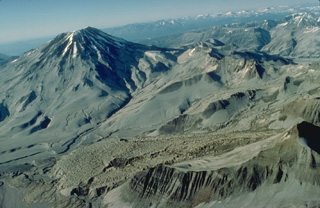 Mount Griggs is the prominent stratovolcano at the upper left in this aerial view from the SW. The slopes of the volcano are heavily mantled with ash from the 1912 eruption of Novarupta volcano. The 1912 pyroclastic-fall deposits also mantle the irregular surface of Knife Creek Glacier, which flows from right to left behind the ridge in the lower right foreground.
Mount Griggs is the prominent stratovolcano at the upper left in this aerial view from the SW. The slopes of the volcano are heavily mantled with ash from the 1912 eruption of Novarupta volcano. The 1912 pyroclastic-fall deposits also mantle the irregular surface of Knife Creek Glacier, which flows from right to left behind the ridge in the lower right foreground.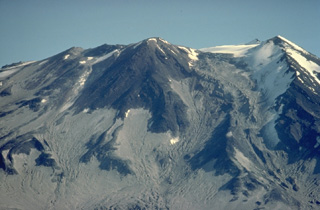 The snow-covered ridge at the right in this view from the south of Mount Griggs is the margin of a large, 1.5-km-wide breached crater formed during the early Holocene during collapse of the volcano's summit. Remnants of the resulting debris-avalanche deposit reach WSW across the valley to Broken Mountain. The young central cone on the center skyline filled the collapse amphitheater and displays nested craters.
The snow-covered ridge at the right in this view from the south of Mount Griggs is the margin of a large, 1.5-km-wide breached crater formed during the early Holocene during collapse of the volcano's summit. Remnants of the resulting debris-avalanche deposit reach WSW across the valley to Broken Mountain. The young central cone on the center skyline filled the collapse amphitheater and displays nested craters.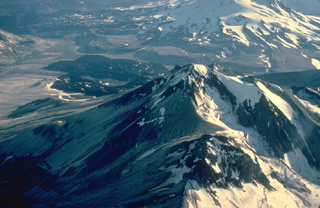 An aerial view from the east shows Mount Griggs in the foreground with the distal end of the Valley of Ten Thousand Smokes (VTTS) ash-flow deposit in the distance, forming the flat, light-colored valley floor at the upper left. The VTTS ash flow was erupted in 1912 from Novarupta volcano; it traveled 21 km to the location shown in this photo. Griggs volcano is the highest of a group of volcanoes in the Katmai area. Three concentric craters are breached to the SW, the largest of which was formed by edifice collapse during the early Holocene.
An aerial view from the east shows Mount Griggs in the foreground with the distal end of the Valley of Ten Thousand Smokes (VTTS) ash-flow deposit in the distance, forming the flat, light-colored valley floor at the upper left. The VTTS ash flow was erupted in 1912 from Novarupta volcano; it traveled 21 km to the location shown in this photo. Griggs volcano is the highest of a group of volcanoes in the Katmai area. Three concentric craters are breached to the SW, the largest of which was formed by edifice collapse during the early Holocene. Griggs is the highest of a group of volcanoes in the Katmai area, located 10 km behind the volcanic arc. Active fumaroles are within the summit crater and along the upper SW flank. Tephra from the 1912 Novarupta eruption cover the flanks in this 1990 view from the SW.
Griggs is the highest of a group of volcanoes in the Katmai area, located 10 km behind the volcanic arc. Active fumaroles are within the summit crater and along the upper SW flank. Tephra from the 1912 Novarupta eruption cover the flanks in this 1990 view from the SW.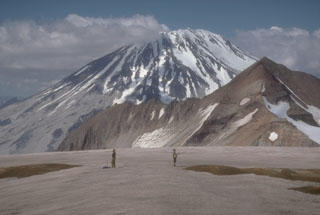 Griggs, seen here from the west rim of Katmai caldera, lies west of a NE-trending arc of volcanoes cutting across Katmai National Park. Noisy fumarolic jets at the summit can be heard across long distances.
Griggs, seen here from the west rim of Katmai caldera, lies west of a NE-trending arc of volcanoes cutting across Katmai National Park. Noisy fumarolic jets at the summit can be heard across long distances.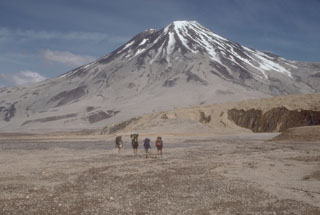 Geologists walk toward Griggs volcano from the base of Knife Creek Glacier to its south. Active fumarole fields persist in the summit crater and along the upper SW flank, and can be heard from the valley floor. The flanks of Griggs and the surface of Knife Creek Glacier have thick ash deposits from the 1912 Novarupta eruption.
Geologists walk toward Griggs volcano from the base of Knife Creek Glacier to its south. Active fumarole fields persist in the summit crater and along the upper SW flank, and can be heard from the valley floor. The flanks of Griggs and the surface of Knife Creek Glacier have thick ash deposits from the 1912 Novarupta eruption.There are no samples for Griggs in the Smithsonian's NMNH Department of Mineral Sciences Rock and Ore collection.
| Alaska Volcano Observatory (Link to Griggs) | The Alaska Volcano Observatory (AVO) is a joint program of the U.S. Geological Survey (USGS), the Geophysical Institute of the University of Alaska Fairbanks (UAFGI), and the State of Alaska Division of Geological and Geophysical Surveys (ADGGS). AVO was formed in 1988, and uses federal, state, and university resources to monitor and study Alaska's hazardous volcanoes, to predict and record eruptive activity, and to mitigate volcanic hazards to life and property. |
| Copernicus Browser | The Copernicus Browser replaced the Sentinel Hub Playground browser in 2023, to provide access to Earth observation archives from the Copernicus Data Space Ecosystem, the main distribution platform for data from the EU Copernicus missions. |
| MIROVA | Middle InfraRed Observation of Volcanic Activity (MIROVA) is a near real time volcanic hot-spot detection system based on the analysis of MODIS (Moderate Resolution Imaging Spectroradiometer) data. In particular, MIROVA uses the Middle InfraRed Radiation (MIR), measured over target volcanoes, in order to detect, locate and measure the heat radiation sourced from volcanic activity. |
| MODVOLC Thermal Alerts | Using infrared satellite Moderate Resolution Imaging Spectroradiometer (MODIS) data, scientists at the Hawai'i Institute of Geophysics and Planetology, University of Hawai'i, developed an automated system called MODVOLC to map thermal hot-spots in near real time. For each MODIS image, the algorithm automatically scans each 1 km pixel within it to check for high-temperature hot-spots. When one is found the date, time, location, and intensity are recorded. MODIS looks at every square km of the Earth every 48 hours, once during the day and once during the night, and the presence of two MODIS sensors in space allows at least four hot-spot observations every two days. Each day updated global maps are compiled to display the locations of all hot spots detected in the previous 24 hours. There is a drop-down list with volcano names which allow users to 'zoom-in' and examine the distribution of hot-spots at a variety of spatial scales. |
|
WOVOdat
Single Volcano View Temporal Evolution of Unrest Side by Side Volcanoes |
WOVOdat is a database of volcanic unrest; instrumentally and visually recorded changes in seismicity, ground deformation, gas emission, and other parameters from their normal baselines. It is sponsored by the World Organization of Volcano Observatories (WOVO) and presently hosted at the Earth Observatory of Singapore.
GVMID Data on Volcano Monitoring Infrastructure The Global Volcano Monitoring Infrastructure Database GVMID, is aimed at documenting and improving capabilities of volcano monitoring from the ground and space. GVMID should provide a snapshot and baseline view of the techniques and instrumentation that are in place at various volcanoes, which can be use by volcano observatories as reference to setup new monitoring system or improving networks at a specific volcano. These data will allow identification of what monitoring gaps exist, which can be then targeted by remote sensing infrastructure and future instrument deployments. |
| Volcanic Hazard Maps | The IAVCEI Commission on Volcanic Hazards and Risk has a Volcanic Hazard Maps database designed to serve as a resource for hazard mappers (or other interested parties) to explore how common issues in hazard map development have been addressed at different volcanoes, in different countries, for different hazards, and for different intended audiences. In addition to the comprehensive, searchable Volcanic Hazard Maps Database, this website contains information about diversity of volcanic hazard maps, illustrated using examples from the database. This site is for educational purposes related to volcanic hazard maps. Hazard maps found on this website should not be used for emergency purposes. For the most recent, official hazard map for a particular volcano, please seek out the proper institutional authorities on the matter. |
| IRIS seismic stations/networks | Incorporated Research Institutions for Seismology (IRIS) Data Services map showing the location of seismic stations from all available networks (permanent or temporary) within a radius of 0.18° (about 20 km at mid-latitudes) from the given location of Griggs. Users can customize a variety of filters and options in the left panel. Note that if there are no stations are known the map will default to show the entire world with a "No data matched request" error notice. |
| UNAVCO GPS/GNSS stations | Geodetic Data Services map from UNAVCO showing the location of GPS/GNSS stations from all available networks (permanent or temporary) within a radius of 20 km from the given location of Griggs. Users can customize the data search based on station or network names, location, and time window. Requires Adobe Flash Player. |
| DECADE Data | The DECADE portal, still in the developmental stage, serves as an example of the proposed interoperability between The Smithsonian Institution's Global Volcanism Program, the Mapping Gas Emissions (MaGa) Database, and the EarthChem Geochemical Portal. The Deep Earth Carbon Degassing (DECADE) initiative seeks to use new and established technologies to determine accurate global fluxes of volcanic CO2 to the atmosphere, but installing CO2 monitoring networks on 20 of the world's 150 most actively degassing volcanoes. The group uses related laboratory-based studies (direct gas sampling and analysis, melt inclusions) to provide new data for direct degassing of deep earth carbon to the atmosphere. |
| Large Eruptions of Griggs | Information about large Quaternary eruptions (VEI >= 4) is cataloged in the Large Magnitude Explosive Volcanic Eruptions (LaMEVE) database of the Volcano Global Risk Identification and Analysis Project (VOGRIPA). |
| EarthChem | EarthChem develops and maintains databases, software, and services that support the preservation, discovery, access and analysis of geochemical data, and facilitate their integration with the broad array of other available earth science parameters. EarthChem is operated by a joint team of disciplinary scientists, data scientists, data managers and information technology developers who are part of the NSF-funded data facility Integrated Earth Data Applications (IEDA). IEDA is a collaborative effort of EarthChem and the Marine Geoscience Data System (MGDS). |